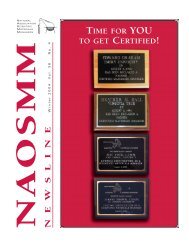Laboratory Safety Guidance
OSHA Lab Safety Guidance - ORS Optical Remote Sensing ...
OSHA Lab Safety Guidance - ORS Optical Remote Sensing ...
- No tags were found...
Create successful ePaper yourself
Turn your PDF publications into a flip-book with our unique Google optimized e-Paper software.
NOTE: The following information has been adapted<br />
from Biosafety in Microbiological and Biomedical<br />
Laboratories, 5th Ed. (BMBL, 5th Ed.), which is published<br />
jointly by the U.S. Centers for Disease Control<br />
and Prevention (CDC) and the National Institutes of<br />
Health (NIH), and is available online at<br />
www.cdc.gov/od/ohs/biosfty/bmbl5/bmbl5toc.htm.<br />
<strong>Laboratory</strong> workers and supervisors are strongly<br />
urged to review this publication directly before engaging<br />
in any experimentation.<br />
Biosafety Level 1 (BSL-1)<br />
BSL-1 is appropriate for working with microorganisms<br />
that are not known to cause disease in healthy<br />
humans. BSL-l practices, safety equipment, and facility<br />
design and construction are appropriate for undergraduate<br />
and secondary educational training and<br />
teaching laboratories, and for other laboratories in<br />
which work is done with defined and characterized<br />
strains of viable microorganisms not known to consistently<br />
cause disease in healthy adult humans. Bacillus<br />
subtilis, Naegleria gruberi, infectious canine hepatitis<br />
virus, and exempt organisms under the NIH<br />
Recombinant DNA Guidelines (http://www4.od<br />
nih.gov/oba/rac/guidelines/guidelines.html) are representative<br />
of microorganisms meeting these criteria.<br />
Many agents not ordinarily associated with disease<br />
processes in humans are, however, opportunistic<br />
pathogens and may cause infection in the young, the<br />
aged, and immunodeficient or immunosuppressed<br />
individuals. Vaccine strains that have undergone multiple<br />
in vivo passages should not be considered avirulent<br />
simply because they are vaccine strains.<br />
BSL-1 represents a basic level of containment that<br />
relies on standard microbiological practices with no<br />
special primary or secondary barriers recommended,<br />
other than a sink for hand washing.<br />
Biosafety Level 2 (BSL-2)<br />
The facility, containment devices, administrative controls,<br />
and practices and procedures that constitute<br />
BSL-2 are designed to maximize safe working conditions<br />
for laboratory personnel working with agents of<br />
moderate risk to personnel and the environment. BSL-<br />
2 practices, equipment, and facility design and construction<br />
are applicable to clinical, diagnostic, teaching,<br />
and other laboratories in which work is done with<br />
the broad spectrum of indigenous moderate-risk<br />
agents that are present in the community and associated<br />
with human disease of varying severity. With<br />
good microbiological techniques, these agents can be<br />
used safely in activities conducted on the open bench,<br />
provided the potential for producing splashes or<br />
aerosols is low. Hepatitis B virus, H1V, the salmonellae,<br />
and Toxoplasma spp. are representative of<br />
microorganisms assigned to this containment level.<br />
Biosafety Level 2 is also appropriate when work is<br />
done with any human-derived blood, body fluids, tissues,<br />
or primary human cell lines where the presence<br />
of an infectious agent may be unknown. <strong>Laboratory</strong><br />
personnel in the United States working with humanderived<br />
materials should refer to the U.S.<br />
Occupational <strong>Safety</strong> and Health Administration<br />
(OSHA) Bloodborne Pathogens Standard (OSHA<br />
1991), available online at<br />
www.osha.gov/pls/oshaweb/owadisp.show_document?p_table=STANDARDS7p_id=1005,<br />
for required<br />
precautions.<br />
Primary hazards to personnel working with these<br />
agents relate to accidental percutaneous or mucous<br />
membrane exposures, or ingestion of infectious<br />
materials. Extreme caution should be taken with contaminated<br />
needles or sharp instruments. Even though<br />
organisms routinely manipulated at Biosafety Level 2<br />
are not known to be transmissible by the aerosol<br />
route, procedures with aerosol or high splash potential<br />
that may increase the risk of such personnel exposure<br />
must be conducted in primary containment<br />
equipment, or in devices such as a biological safety<br />
cabinet (BSC) or safety centrifuge cups. Personal protective<br />
equipment (PPE) should be used as appropriate,<br />
such as splash shields, face protection, gowns,<br />
and gloves.<br />
Secondary barriers such as hand washing sinks and<br />
waste decontamination facilities must be available to<br />
reduce potential environmental contamination.<br />
Biosafety Level 3 (BSL-3)<br />
BSL-3 is suitable for work with infectious agents<br />
which may cause serious or potentially lethal diseases<br />
as a result of exposure by the inhalation route. This<br />
may apply to clinical, diagnostic, teaching, research,<br />
or production facilities in which work is done with<br />
indigenous or exotic agents with potential for respiratory<br />
transmission, and which may cause serious and<br />
potentially lethal infection. Mycobacterium tuberculosis,<br />
St. Louis encephalitis virus, and Coxiella burnetti<br />
are representative of the microorganisms assigned to<br />
this level. Primary hazards to personnel working with<br />
these agents relate to autoinoculation, ingestion, and<br />
exposure to infectious aerosols.<br />
At BSL-3, more emphasis is placed on primary and<br />
secondary barriers to protect personnel in contiguous<br />
4 2<br />
Occupational <strong>Safety</strong> and<br />
Health Administration



